|
Japanese Puzzle Boxes
| By Jerry Slocum
|
 |
Japan has exported secret
opening boxes to the West since before 1870. They are often complex,
requiring many "moves" to open them. The puzzle is to find the
secret compartment inside.
To solve a puzzle box, one
or more sliding parts in one end are moved, allowing the other end
to be moved slightly. This partially unlocks a side panel, which
allows other pieces to be moved. These, in turn, partially unlock
the top or bottom. This method is continued, moving around the box,
until the top panel can slide, opening the box.
Most of the very early
puzzle boxes from the late 1800s/early 1900s only had a few moves to
open, usually 2 to 4. They can sell for several hundred dollars if
they are in good condition and work properly.

|
|
Contact
us to
place your antique
shop or antique
related
information
here.
|
|

|
|
|
|
|
|

|
|
Puzzle boxes were often
beautifully lacquered or veneered. The elaborate wood mosaic is
called yoseki, a craft practiced for centuries in Japan. It uses the
natural grain and texture of a wide variety of woods. Woods of many
colors are selected-spindlewood for white, Katursa for black, sumac
or mulberry for yellow, camphor for brown, American walnut for
purple, Japanese cucumber for blue, Chinese cedar for red, and so
on.
Oblong rods of the desired
cross sections are selected and glued together to form the geometric
pattern desired. Subsequently, the sectional surface is sliced into
very thin sheets of veneer that can be glued onto the surface of the
box. The box is then glazed and polished.
By choosing wood of
different cross sections-squares, regular and irregular hexagons,
etc.-and of different colors, it is possible to design patterns of
great beauty and complexity. These serve not only to decorate the
boxes. They also play an important role in concealing the sliding
pieces, which must be moved to open them.
It is likely that Japan was
making puzzle boxes before 1800, but it was a closed society until
Admiral Perry opened Japan to trade in 1854. Within about a decade
after Japan began to trade with other countries, the Japanese
jewel-box was being sold in the 1867 "Adams & Co. of Boston
Catalogue." It states in the catalogue, "Genuine Japanese
manufacture."
In 1896, the Marinka & Co. Catalogue showed a
Japanese inlaid puzzle box. This box had a drawer that slid out from
four different directions.
Dating old Japanese puzzle boxes. The
McKinley Tariff Act of 1891 required the country of origin to be
marked on items imported to the USA. From March 1891 until September
1921, Japanese goods were supposed to be marked with the country of
origin. The Japanese choose to use the word Nippon for their
marking.
The Act was strengthened in 1921 so products were to be
marked "Japan" or "Made in Japan." From 1945 to 1952, the required
marking was "Made in Occupied Japan." After 1952, "Made in Japan"
was supposed to be marked on goods exported to the U.S. Much more
accurate dating of puzzles can be done by the use of novelty, puzzle
and magic catalogs.
Pre-World War II puzzle boxes were smaller,
made of dark colored woods and frequently exhibit fine workmanship.
Post World War II puzzle boxes were made with lighter colored woods
and are larger in size.
Solutions for puzzle boxes frequently
require sliding sections of the ends of the boxes as well as the top
and bottom. The level of difficulty in solving the problem varies
widely-some boxes only require two moves to open them, while others
require as many as 122 moves to solve.
Sizing up a puzzle
box.
The traditional Japanese unit of measure is called
a "sun." A sun is about 1.22 inches, and curiously, it is a unit of
measure for length only, not width or height. Small puzzle boxes are
1, 2 or 3 sun in size. Medium boxes are 4 sun, and a standard size
is 5 sun. Large puzzle boxes are 6 and 7 sun.
Our thanks to
Jerry Slocum. His latest book, The Tangram Book, contains the first
comprehensive history of one of the world's most popular puzzles, as
well as 2,000 Tangram puzzles to solve. It is available at Barnes
& Noble, Amazon.com and most bookstores. Unless otherwise noted,
photos are courtesy Jerry Slocum.
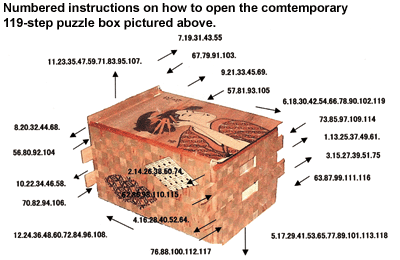
|
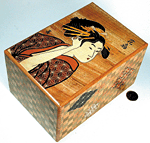
119
moves are needed to open this beautiful puzzle box made by the late
Master Craftsman, Yoshio Okiyama. (The illustration of the Japanese
girl is Zougan Art of Ukiyoe by Yoshihiro
Ishikawa.)
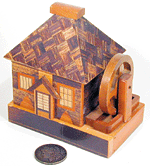
Watermill puzzle bank.
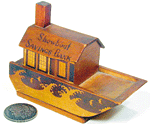
Boat
puzzle bank.
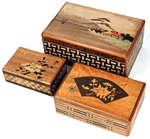
Japanese puzzle boxes from the 1920s to 1930s. The
two smaller boxes are also banks with slots for coins and only two
or three moves are needed to retrieve the money.
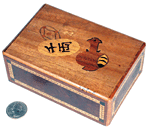
A 1937
puzzle box with a hidden coin slot and drawer. Four moves open the
box.

The
upper puzzle box contains a noise maker that produces a "moo" sound
when the box is tilted. The middle box requires nine moves to open a
secret compartment and drawer, and ten moves are needed to open the
secret compartment in the lower box.
|
| More Puzzle Box History
The Himitsu-Bako (personal
secret box) is a traditional Japanese puzzle box that was designed
over 100 years ago in the Hakone region of Japan. The Hakone
Mountains are noted for their great variety of trees. The creators
of the personal secret box took advantage of this wide variety of
natural wood colors and textures to produce their elaborate
geometric patterns.
The appeal of the personal
secret box is not merely in its entertainment qualities. It is
valued as a mosaic woodwork of the type usually applied to small
handicrafts such as trays, boxes and chests. This marquetry
technique originated in the late Edo Period, and for many years, the
town of Hakone was a relay station on the main road to Edo (present
day Tokyo). The mosaic woodwork was developed as souvenirs for
travelers.
The personal secret box was
first referred to in a journal issued during 1830-1843. In this time
period, the secret box was in its early stages. It was referred to
as a Sikake-Bako and as a Tie-Bako. Sikake means device or trick,
and Tie means idea, wisdom or intelligence. These were small boxes
used to contain strings, nails, sewing kits, etc.
These string boxes were
developed into small chests for use by workers to carry their tools
in and to keep them safe from theft. Because of the device or trick,
no one could get into the box without first knowing the secret.
Workers used these chests on coaches and ships to keep them
secure.
The small string box was
made with a very simple device or trick in the beginning. As this
box became more popular, the device/trick became more complicated.
Up to this point in history, these secret boxes were very simple
with little or no decoration. They did not resemble the secret
puzzle boxes of today.
It was after 1870 that
puzzle boxes were used to keep important documents or secrets safe.
Originally, the boxes were more flat in shape, but soon they were
developed into 5 sun and 6 sun sizes with up to 66 intricate moves
to open.
Most Japanese personal
secret boxes have a variety of difficulties, ranging from 4 to 66
moves. A few large puzzle boxes have exceptional numbers of moves,
such as 78, 122, 119, or 125.
The art of making personal
secret boxes has never been written down. Instead, it has been
passed on from master craftsman to apprentice for generations.
2003
|
Our thanks
to http://www.cleverwood.com/ for the More Puzzle Box
History article. Cleverwood sells many types of wonderful
puzzle boxes on their website. They can also be contacted by calling
888-593-8653.
|